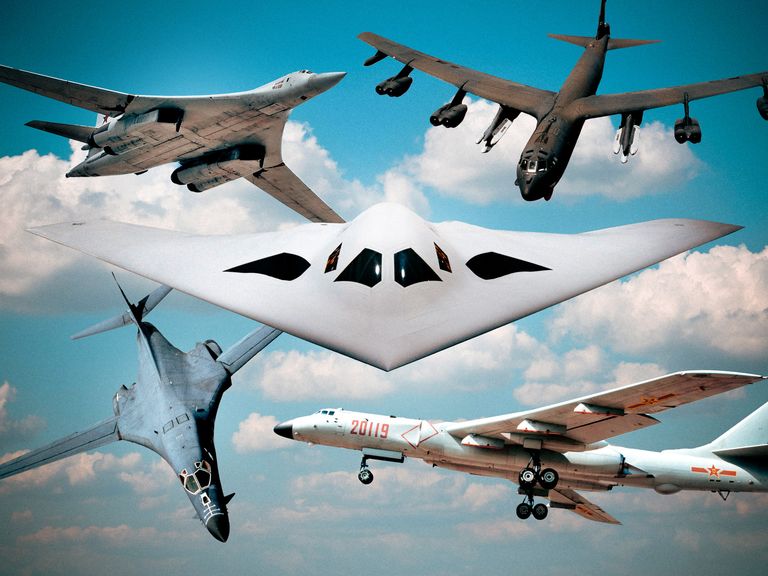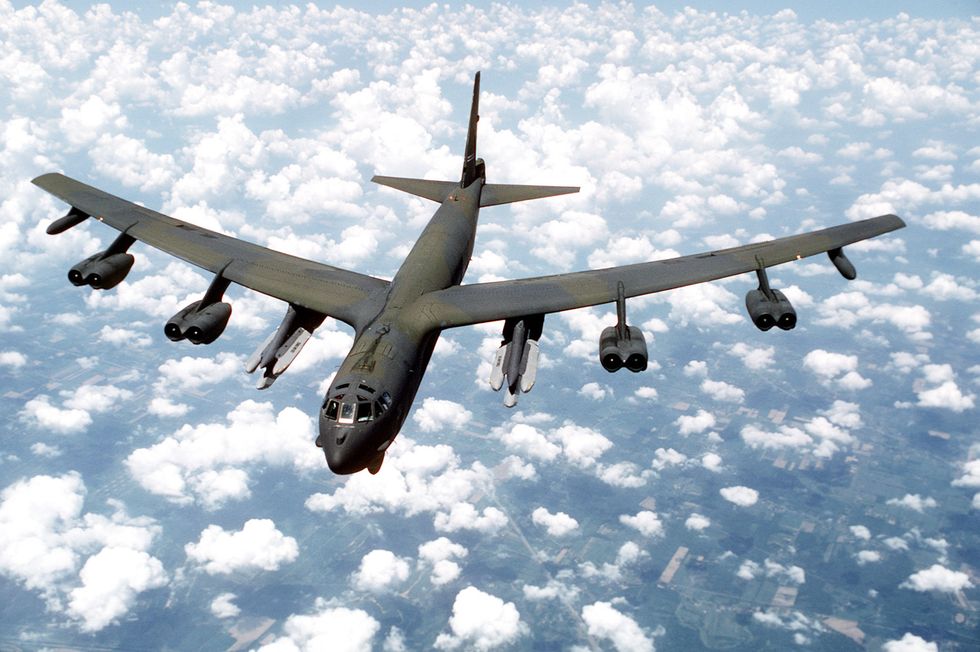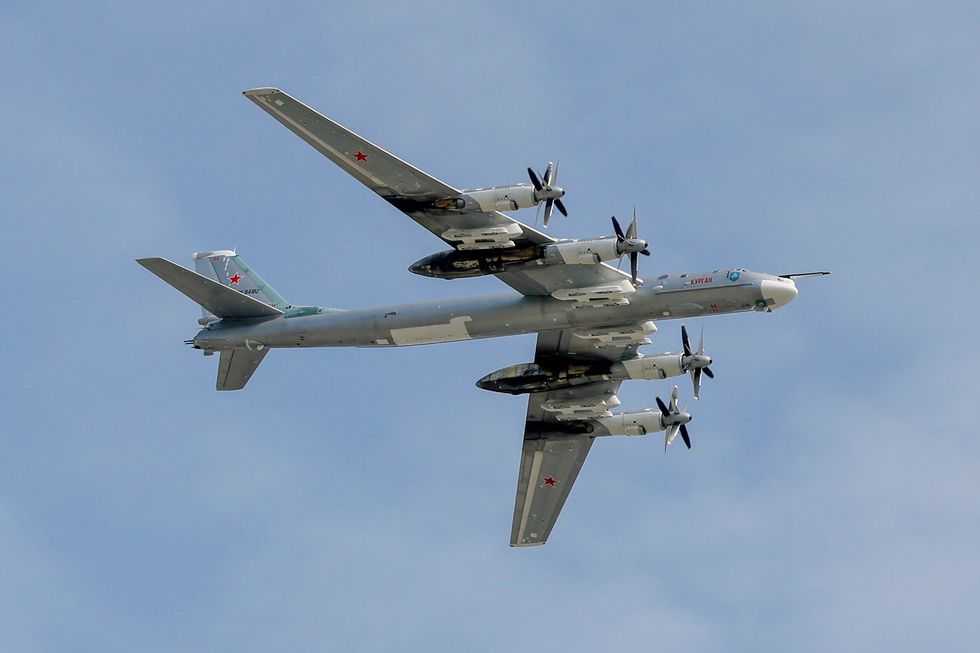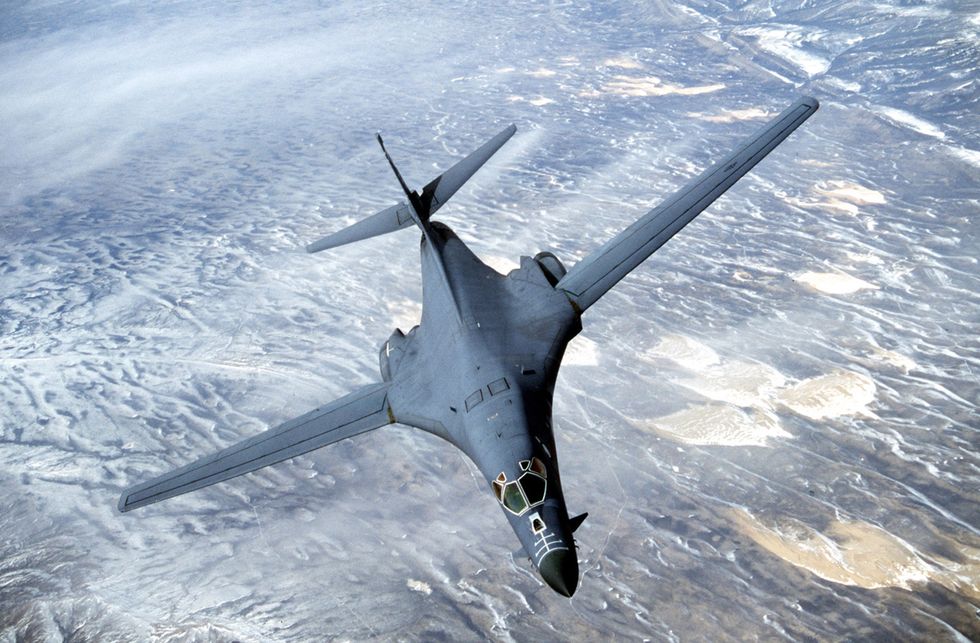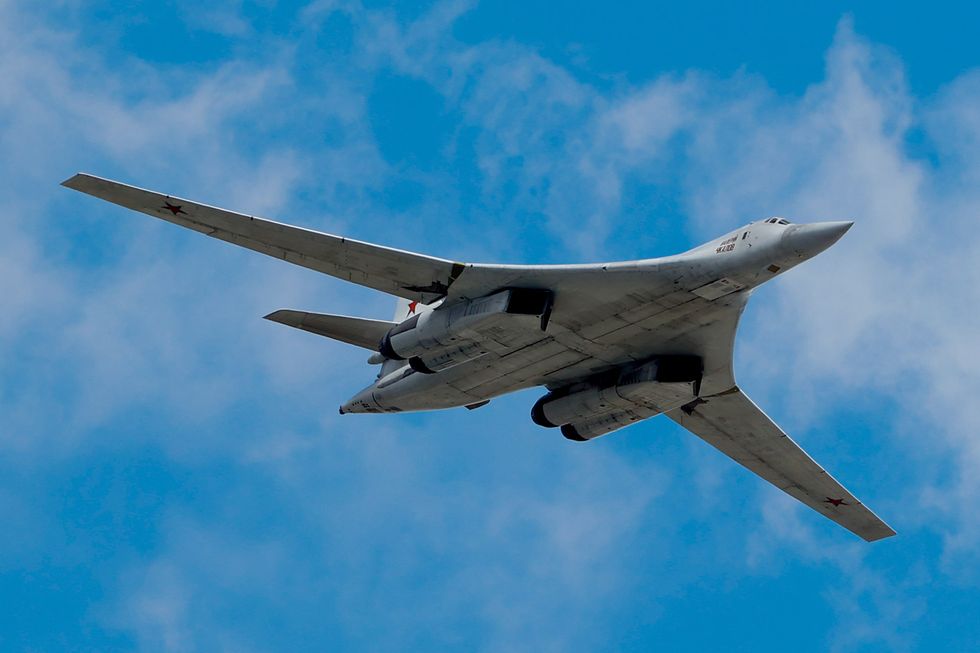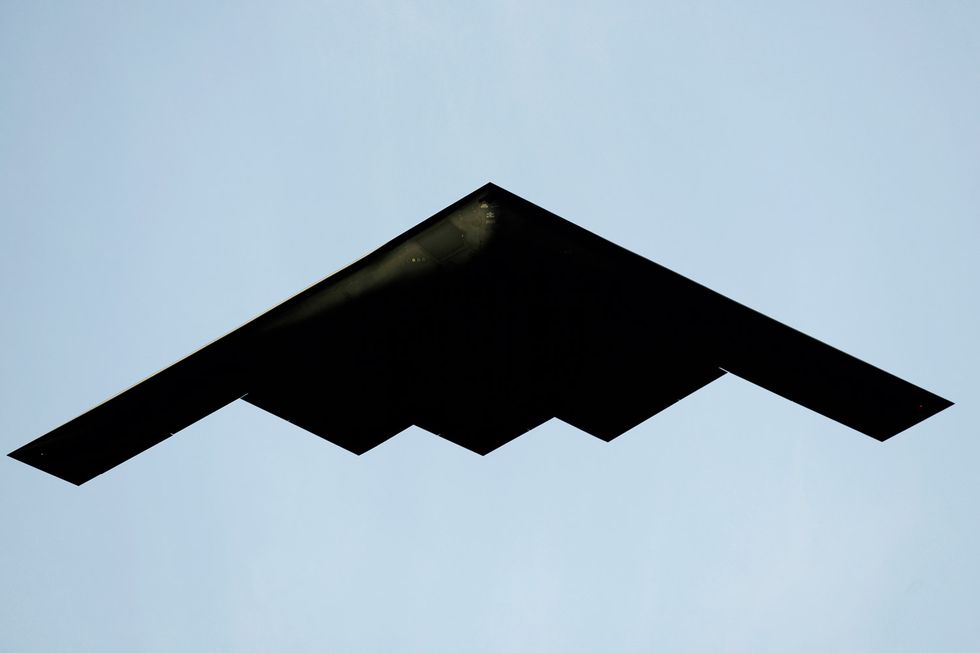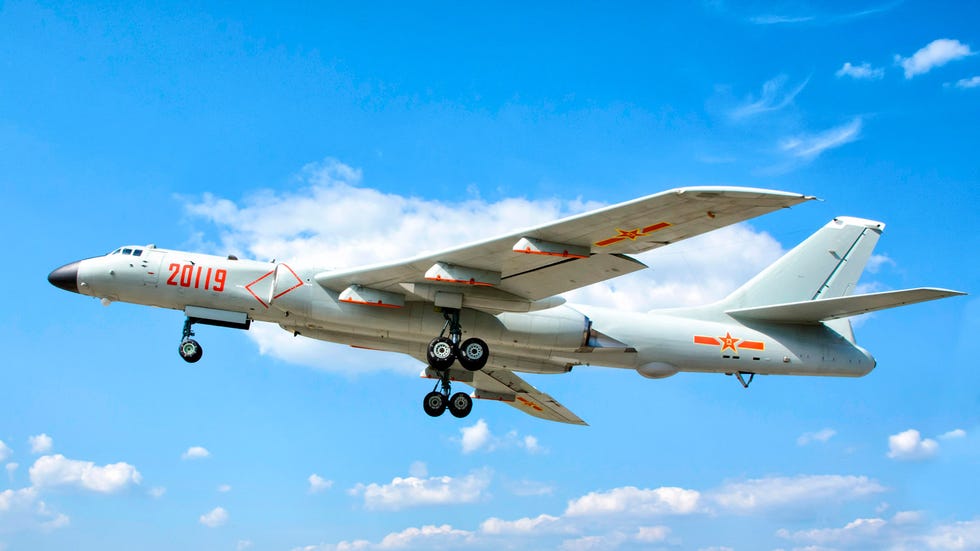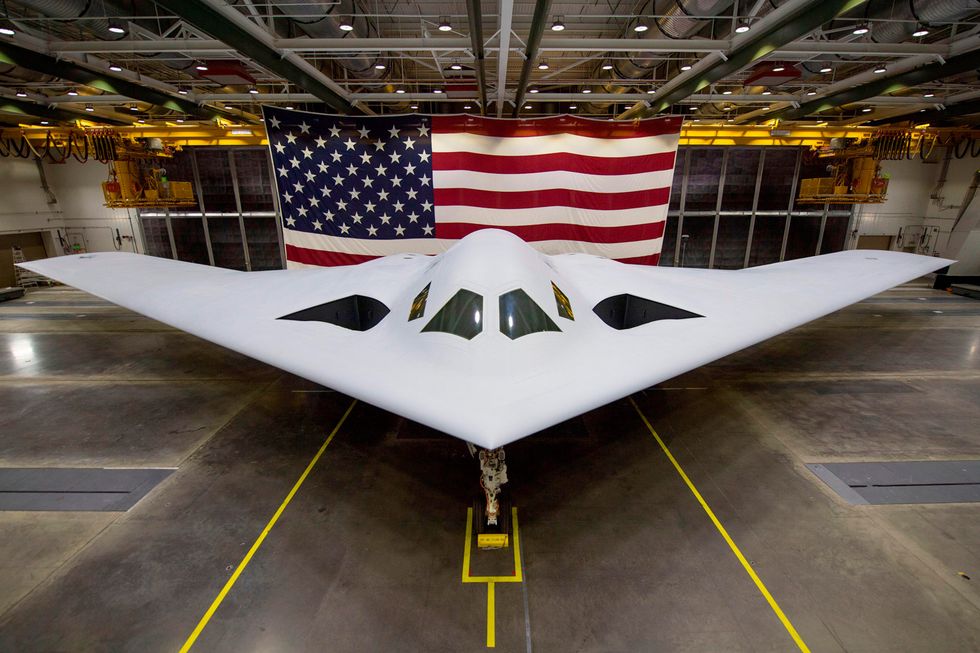Soon after Russia began its invasion of Ukraine in early 2022, a collection of short videos emerged on social media: camera views from aboard small consumer drones that were carefully—almost casually—dropping mortars into the open hatches of Russian tanks, with devastatingly effective results. The tactic signaled both a new age of precision bombing and a new age of improvised delivery of explosives. In other words, it was business as usual for those in the business of innovating the bombing of thine enemies.
Indeed, world militaries have developed a wide variety of ways to sling explosives at one another, from the rudimentary, like hand-tossed grenades, to the clever, like the Ukrainian adaptation of consumer drones, to billion-dollar aircraft flying on daylong missions, invisible to enemy radar as they deliver GPS-guided explosives straight into underground bunkers. Long-range bombers, flying high and surveilling the entire combat theater, can inspire awe and fear. And the ultraprecise guidance systems affixed to their munitions eliminates the need to carpet-bomb entire cities, which had characterized their early use.
While pretty much any kind of aircraft can be outfitted to drop bombs, aircraft dedicated to that specific mission are staggeringly impressive feats of technology. Far from being clumsy behemoths, they bring leaps in performance and capability, and some include the most advanced aerodynamic and stealth innovations, making them highly effective.
Peter Singer, a military analyst and senior fellow with the New America think tank, says people—“including many within the military”—sometimes fail to recognize the value of bombers beyond their traditional bomb-dropping roles.
Singer says the weapons systems with the most longevity are those that can adapt to shifting priorities, such as stealth over speed, and new tactical strategies. “It is their range and carrying capacity that differentiates them,” he says, “and their ability to take on new, added roles that range from electronic warfare to managing swarms of small drones to even potentially air-to-air missions.”
Also, they’re big and loud, and will send a shiver down your spine if you witness one take off in person.
Of course, alternative tactics exist for these systems—intercontinental ballistic missiles can deliver nuclear warheads to targets from thousands of miles away, and smaller rockets can be faster than kinetic ordnance that rely on gravity to get the job done. But there are limits to those high-speed systems, including cost, range, payload capacity, and a multitude of strategic challenges that bombers—with their ability to loiter and deliver ordnance with surgical precision—can mitigate.
“While technology may change, geography doesn’t,” Singer says. “You need the ability to operate across great distances, especially in the Pacific. And in various scenarios versus China and Russia, the U.S. needs more options.”
By that he means the ability to navigate around—or slip through—more sophisticated air defenses. The radar invisibility of the B-2 stealth bomber is legendary. And the B-52 Stratofortress can fly high enough to avoid many defenses. Bombers can also use the weapons in a conventional fight against less technologically advanced adversaries, where missiles and rockets aren’t required to circumvent defense systems, and deliver more and larger individual bombs than other systems could.
Bombers can also be highly effective deterrents, often as impactful as aircraft carrier battle groups when those arrive on the scene of a brewing conflict. Of course, bombers can also be provocative, revealing potential troublemakers and gauging tensions. In late October 2023, a Chinese J-11 fighter jet got up close and personal with a U.S. Air Force B-52 bomber that the Department of Defense says was conducting routine operations in the international waters of the South China Sea. It behaved antagonistically, as is often the case in such confrontations, before going on its way.
So an active, broadly capable bomber fleet, far from being anachronistic, is truly foundational in today’s military. That’s the reason the aforementioned B-52 is—astonishingly—nearing its 70th anniversary of active duty. It’s also why plenty of intermediate options exist and why a brand-new option, the recently unveiled Northrop Grumman B-21 Raider, is raising so many curious eyebrows.
As for the bombing capabilities of U.S. adversaries, those bombers can’t match the technological prowess of the U.S. fleet, but they can be devastatingly effective nonetheless. It’s just that new bombers are few and far between and troubled by their own challenges. “Any talk of a new Russian bomber has been kind of dashed because of sanctions and combat losses,” notes aircraft industry analyst Richard Aboulafia, a managing director at the defense consultancy AeroDynamic Advisory. “If there’s any talk of something to replace China’s Xian H-6K, a regional bomber,” he adds, “there’s been nothing definite. The Chinese are a long way from having anything like what we have coming next.”
But while we may not see anything new from our military adversaries in the near future, that doesn’t mean existing capabilities aren’t still formidable, or that the pursuit of smarter ways of delivering explosives won’t continue to evolve even with legacy aircraft on both sides. After all, the first entry in this roundup of the most deadly bombers in the world has seen its fair share of evolution, even if its core design hasn’t changed in seven decades. It remains an intimidating, and awesome, aircraft.
Boeing B-52 Stratofortress
Most dangerous feature: 8,800-mile range without refueling
All conversations about bombers must begin with this OG, the legendary Boeing-built B-52 Stratofortress. This sprawling strategic bomber entered service in 1955, and over the course of the barely seven years of production that followed, 742 samples were built; 72 remain in service today. The model has been updated continuously and adapted for virtually every military conflict the U.S. has participated in since that early Cold War era.
The B-52’s longevity can be attributed to its robust original design and its upgrade-friendly internal space, which allows for wholesale replacement of entire systems. Over the years, this 160-foot-long, 185-foot-wingspan bird, known as BUFF—for Big Ugly Fat, uh, Fella—has seen new armaments, including cruise missiles and nuclear missiles, enter its weapons bay; it will eventually see hypersonic missiles loaded on board once those enter service. Avionics, communications, and networking upgrades have been fairly steady, and the aircraft is due to receive a new digital cockpit starting within the next five years. This year the Air Force also began installing a new Active Electronically Scanned Array radar system—used by modern fighter jets such as the F-22 for ultraprecise, multi-target tracking—to replace the 1960s-era radar currently installed in the fleet.
But by far the most substantial upgrade (and a massive vote of confidence if ever there was one) will be the Air Force’s new re-engining program for the B-52s eight engines. The idea of modernizing the engines has been controversial because of the cost involved and the assumption that the bomber would eventually be retired. But the Air Force confirmed in 2021 that it would replace the original Pratt & Whitney TF33-P-3/103 turbofans with larger, more efficient, and quieter Rolls-Royce F130 engines. The B-52 is not a cargo aircraft; up close, its fuselage feels remarkably skinny and compact, though its wide wings make up for it. Still, these engines will enhance the B-52’s overall look significantly, taking an already imposing vibe and pushing it to another level of menace.
Tupolev Tu-95
Most dangerous features: Lengthy loiter time, large nuclear bombs
With a shelf life that closely rivals that of the B-52 Stratofortress, the Tupolev Tu-95 “Bear” is another quirky bomber. Introduced in the mid-1950s and still going strong, the Tu-95 uses turboprops with counter-rotating blades instead of jet engines. The prop tips spin at supersonic velocities, making it one of the loudest aircraft in the world. It’s also one of the few bombers with machine guns for defense, and the only prop-driven aircraft with swept-back wings, which are typically used in high-speed jet aircraft.
But the engineering decisions the Soviet-era designers made for the Tu-95 have resulted in one of the most fearsome packages on the planet. The fuel-efficient turboprop engines give it an unrefueled range of 9,300 miles. That’s 500 more than the B-52’s, mostly benefiting loiter time rather than actual distance. And it’s supremely efficient at lower altitudes. Granted, it can’t outrun most defense systems, but in the absence of those systems, it’s devastating. The bomber’s original mission included carrying nuclear warheads—it famously dropped the largest nuke ever made, the 58-megaton Tsar Bomba, in a 1961 test. But its current weapons include conventional bombs and missiles.
The Tu-95 has been upgraded over the years with new avionics and communications systems, without quite the technological advances the B-52 has enjoyed. It’s been routinely used for low-level maritime operations, including dropping sonar buoys and deploying other electronic surveillance systems. But while the aircraft is expected to fly through 2040, there aren’t practical replacements in the pipeline yet. “Any talk of a new Russian bomber has been kind of dashed because of sanctions and combat losses” related to the Ukraine war, says AeroDynamic Advisory’s Aboulafia.
Rockwell B-1 Lancer
Most dangerous feature: Ability to fly high and fast, or low and slow
The B-1 bomber is a rare bird. The U.S. gave it a unique combination of capabilities and produced just 100 of them. The plane then had a fraught and protracted gestational period that saw a definitive cancellation of the development program in 1977, a surprise reversal of that decision in 1981, and multiple running changes between the original design and the final product.
The end result was a long-range heavy bomber that can fly up to Mach 1.25, travel as far as 6,500 miles, and carry up to 75,000 pounds of conventional bombs, nuclear weapons, or rockets and missiles, including the AGM-158 JASSM (Joint Air-to-Surface Standoff Missile), a stealthy, winged missile with an armor-piercing warhead.
The plan has a swoopy design that seems to want bell bottoms on the landing gear and feathered haircuts on the pilots, and a rare variable-sweep wing that was briefly in vogue among aerospace engineers but which allowed it to alternate between low-speed, low-altitude bombing and high-altitude supersonic flight.
“The B-1 is truly an oddity,” Aboulafia says. “It was a creature of the ’60s, built in the ’80s, very expensive, pre-stealth, and just kind of that fascinating last gasp of all of the tremendous creations of the heart of the Cold War.”
But for all its weirdness, it ticked a lot of essential boxes. “It’s the only aircraft that I know of that has somehow managed to combine range, payload, and speed,” Aboulafia says. For that reason, it earned its role in a variety of missions, including, most recently, hundreds of flights above Afghanistan and Syria. Thanks to a slew of upgrades to its avionics, targeting systems, and payload capabilities, the Air Force intends to keep the B-1 in service through at least 2036, when it will be fully displaced by the B-21.
Tupolev Tu-160 Blackjack
Most dangerous feature: Speed
This visual copycat of the U.S. B-1 Lancer takes the idea of a supersonic, long-range, sweep-wing performance bomber and pushes everything to 11. It’s faster than the B-1, able to reach Mach 2.05 to the B-1’s Mach 1.2, and second only to the U.S.’s experimental Mach 3 XB-70 Valkyrie on outright speed for a bomber. It can travel as far as 7,700 miles without refueling, outflying the B-1 by more than 1,000 miles. It even has the same groovy styling as the B-1, having cribbed the blended wing and fuselage design from its U.S. counterpart.
But similarities in design don’t always equal similarities elsewhere. Despite having a reduced budget compared to the Tu-160, the B-1 engineers had a broader understanding of the science and technology required to make the aircraft perform as needed, and to do so reliably. The Tu-160 has been plagued by readiness issues as well as performance restrictions: A flaw in the engine time means it can fly at its top speed only for short periods of time.
The long-range bomber entered service in 1987 and has received a variety of upgrades since. The most recent version, the Tu-160M, currently undergoing prototype testing, consists of 80 percent upgraded systems and equipment, according to Defense News. It also has new engines and will carry the latest weapons, including Russia’s new hypersonic missile—if that development process succeeds. Russia hopes to roll out 10 retrofitted Tu-160s by 2027—a stark contrast to the number of new B-1 bombers planned: zero.
Northrop Grumman B-2 Spirit
Most dangerous feature: Stealth
When it entered service in 1997 after a 16-year development and test program, the B-2 Spirit—a.k.a. the Stealth Bomber—was as much a breakthrough for its near-invisibility to enemy radar as its striking flying-wing configuration. The former came from decades of research and development into “low-observable” technology; the latter was made possible through complex digital flight controls that automatically stabilized the airplane in flight.
Due to runaway manufacturing and operating costs, however, the Air Force would reduce its procurement from 130 samples to just 21. (One was lost in a crash, and 20 remain in active service.) But the B-2 has acquitted itself well in its quarter century of service, never once being fired upon during extensive bombing campaigns in the Kosovo War, the 1991 Gulf War, Operation Enduring Freedom in Afghanistan, the Iraq War, and the battle against ISIS, among others. It typically flies missions directly from Whiteman Air Force Base in Missouri to the target, flying up to 15,000 miles round trip over up to 30 hours, with multiple aerial refuelings. (It has flown from other bases, including forward locations during conflicts.) It carries up to 40,000 pounds of conventional bombs or nuclear warheads in its two internal bays.
Though the B-2 is scheduled for gradual replacement by, yes, the B-21 Raider beginning in 2027, the Air Force is committed to the B-2, with billions of dollars in upgrades scheduled for the fleet to help it last until at least 2032. At the end of the day, it will likely be most remembered for shifting the priorities of the Air Force. “The B-1 could do a high-speed supersonic dash with significant range and payload, but with the B-2 we said we didn’t want those three things,” Aboulafia says. “We now wanted range, payload, and stealth, not speed. And the B-21, of course, will have the same parameters.”
Xian H-6
Most dangerous feature: Can fire multiple supersonic missiles at a carrier battle group
While most militaries outside the U.S. have negligible bomber capabilities, China is a notable exception. Its twin-engine H-6 is a serious threat. Adapted by the Chinese manufacturer Xi’an Aircraft Industrial Corporation from the Soviet Tupolev Tu-16, the plane is not only capable of aerial refueling to extend its range but also able to launch cruise missiles and deploy nuclear weapons, and it’s equipped with modern avionics and radar systems.
Variants include the H-6K, a conventional bomber, and the newer H-6N, a nuclear-capable version that can also launch anti-ship ballistic missiles. The bomber is frequently used in shows of force, most notably when China wants to assert its territorial claims over Taiwan. Last December, China sent 18 H-6 bombers through Taiwan’s air defense zone in a 24-hour period. It’s also being groomed for next-generation technologies such as drone swarm deployment and electronic warfare capabilities.
Analysts believe China is working on a replacement for the H-6, a flying-wing bomber like the B-21 called the H-20. Despite the similarities, the plane likely won’t deliver the same performance as the U.S. Air Force’s newest bomber—China’s expertise in stealth materials and manufacturing technology still trails America’s, says Aboulafia.
Northrop Grumman B-21 Raider
Most dangerous features: Next-gen stealth and reliability
Though the motley fleet of U.S. bomber aircraft is the best in the world by any measure—and really, it’s no contest—there are still gaps. First and foremost among them is cost: A plane should be able to go deep into enemy territory without breaking the bank with every hour of flight, or requiring countless hours of maintenance between missions. When the B-21 Raider took its first official flight in November 2023, it injected a new generation of performance and stealth technology into the bomber arsenal. The plane significantly outperforms the B-2 Spirit in terms of cost-effectiveness due to its vastly increased fuel efficiency and—the Department of Defense hopes, anyway—its greater reliability.
The older B-2 costs more than $150,000 per hour to operate, thanks to high maintenance expenses and an inherently inefficient engine configuration—to make the plane stealthier, its designers buried its four power plants deep inside the aircraft to conceal their fan disks and heat signatures. The B-21 solves those problems. “Nothing’s really been confirmed yet in terms of new innovations, but one challenge would be using a high-bypass turbofan engine that would be much better on fuel consumption and therefore range,” Aboulafia says. High-bypass engines, similar to those on commercial airliners, generate greater thrust from larger fan diameters and are therefore more fuel efficient. “You couldn’t reconcile that with stealth until now,” he says. “On the B-2, you have much bigger inlets, and apparently they’ve found a way to create a stealthy inlet and duct that allows for a larger bypass engine inside.”
Aboulafia says the bomber has plenty of other important innovations, including advances in materials and manufacturing processes, onboard electronics, stealth coatings, and more. It will also be able to deploy hypersonic missiles as those come on line, and coordinate with new drone targeting, reconnaissance, and surveillance drones.
The Air Force expects to purchase more than 100 B-21 bombers, which will help with the economy of scale challenges that have also contributed to the B-2’s high operating costs, as only 21 of those were built. The B-21’s expected life span hasn’t been revealed publicly yet, but the way things are going, the new bird may retire before the B-52 does.
Eric Adams is a writer and photographer who focuses on technology, transportation, science, travel, and other subjects for a wide range of outlets, including Wired, The Drive, Gear Patrol, Men's Health, Popular Science, Forbes, and others.
